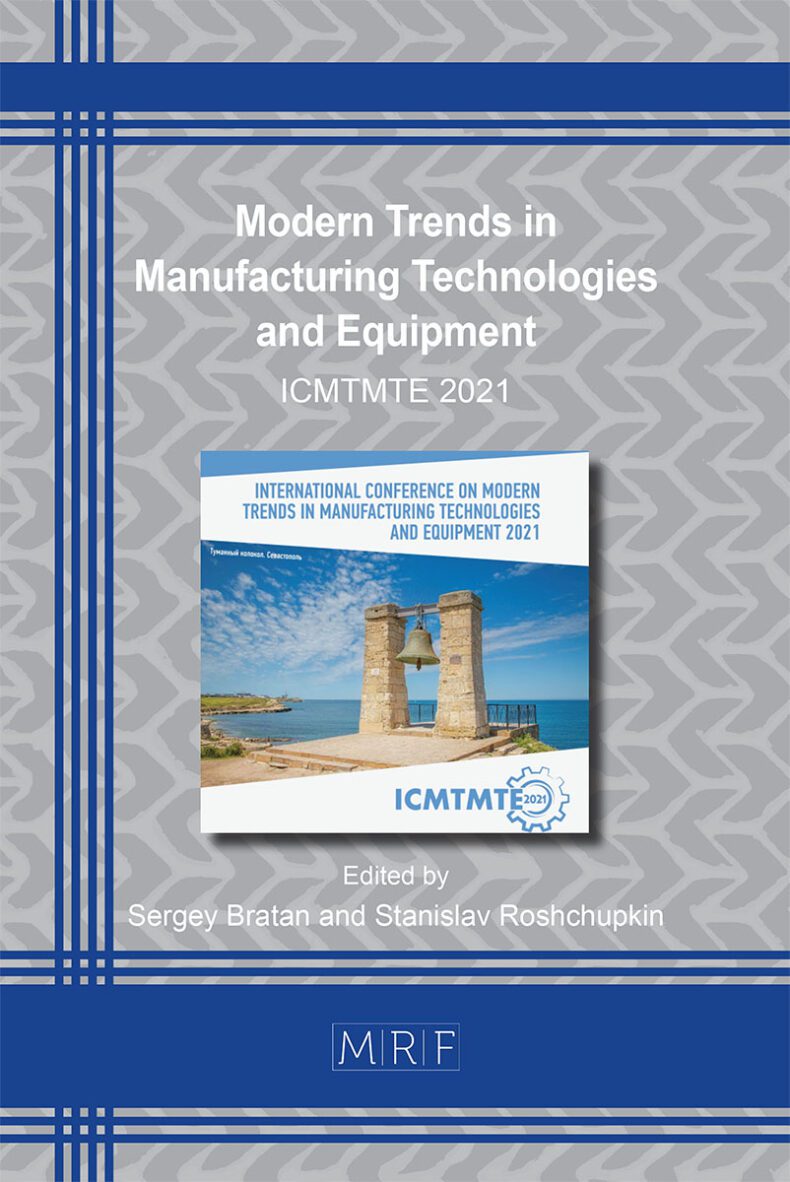Effect of Process Modes on Tangential Component of Cutting Force during Belt Rotary Grinding of Aluminium Alloy Blanks D 16
Tatiana Stadnik, Denis Sidorov, Ilyas Temindarov, Pavel Novikov
download PDFAbstract. These days, in the manufacture of units and mechanisms of ships, aircraft and other technological machines, industrial robots, long-sized products from D 16 (Standart GOST-R) aluminum alloy are used, for the processing of which a complex for belt rotary grinding has been developed. The outcome measures of the rotary belt grinding process depend on the cutting forces generated during the processing process. According to cutting forces, process stability is diagnosed, values of surface roughness indices, temperatures and cutting modes are calculated according to displacement balance equation. The article is devoted to obtaining a mathematical model establishing the relationship between the tangential component of the cutting force and cutting modes during belt rotary grinding of D 16 aluminum alloy.
Keywords
Grinding, Abrasive Belt, Rotary Belt Grinding, Cutting Force
Published online 1/5/2022, 7 pages
Copyright © 2022 by the author(s)
Published under license by Materials Research Forum LLC., Millersville PA, USA
Citation: Tatiana Stadnik, Denis Sidorov, Ilyas Temindarov, Pavel Novikov, Effect of Process Modes on Tangential Component of Cutting Force during Belt Rotary Grinding of Aluminium Alloy Blanks D 16, Materials Research Proceedings, Vol. 21, pp 466-472, 2022
DOI: https://doi.org/10.21741/9781644901755-76
The article was published as article 76 of the book Modern Trends in Manufacturing Technologies and Equipment
![]() Content from this work may be used under the terms of the Creative Commons Attribution 3.0 licence. Any further distribution of this work must maintain attribution to the author(s) and the title of the work, journal citation and DOI.
Content from this work may be used under the terms of the Creative Commons Attribution 3.0 licence. Any further distribution of this work must maintain attribution to the author(s) and the title of the work, journal citation and DOI.
References
[1] S. Bratan, P. Novikov, S. Roshchupkin, Application of Combined Taps for Increasing the Shaping Accuracy of the Internal Threads in Aluminium Alloys, Procedia Engineering. 150 (2016) 802–808. https://doi.org/10.1016/j.proeng.2016.07.115
[2] S.M. Bratan, S.I. Roshchupkin, A.O. Kharchenko, A.S. Chasovitina, Probabilistic model of surface layer removal during grinding of brittle non-metallic materials, Metal processing (technology, equipment, tools). 23 No. 2 (2021) 6-16. (in Russ.). https://doi.org/10.17212/1994-6309-2021-23.2-6-16
[3] S.M. Bratan, S.I. Roshchupkin, A.O. Kharchenko, A.S., Chachavitina Simulation of allowance removal in the contact area during internal grinding of brittle non-metallic materials, Metal processing (technology, equipment, tools). 23 No. 2 (2021) 31-39. (in Russ.). https://doi.org/10.17212/1994-6309-2021-23.2-31-39
[4] S. Bratan, T. Stadnik, S. Roshchupkin, Investigation of the mechanism of interaction of cutting fluids with the material of the workpiece when grinding titanium parts in the presence of inorganic salt, Materials Today: Proceedings. 38 (2021) 2048–2051. https://doi.org/10.1016/j.matpr.2020.10.135
[5] A. Chasovitina, S. Bratan, S. Roshchupkin, The cutting emulsions for grinding ceramics and sitall parts, Materials Today: Proceedings. 38 (2021) 2083–2087. https://doi.org/10.1016/j.matpr.2020.10.153
[6] A. Kharchenko, A. Chasovitina, S. Bratan, Modeling of regularities of change in profile sizes and wear areas of abrasive wheel grains during grinding, Materials Today: Proceedings. 38 (2021) 2088–2091. https://doi.org/10.1016/j.matpr.2020.10.154
[7] S.M. Bratan, Influence of the tool working surface state on evaluation of the forming filter parameters, IOP Conference Series: Materials Science and Engineering. 709(2) (2020) 022009. https://doi.org/10.1088/1757-899X/709/2/022009
[8] S. Bratan, B. Bogutsky, S. Roshchupkin, Development of mathematical model of material removal calculation for combined grinding process, Lecture Notes in Mechanical Engineering. 9783319956299 (2019) 1759–1769. https://doi.org/10.1007/978-3-319-95630-5_189
[9] S. Bratan, E. Vladetskaya, Flat grinding model, considering internal dynamics of the process MATEC Web of Conferences. 224 (2018) 01002. https://doi.org/10.1051/matecconf/201822401002
[10] S. Bratan, S. Roshchupkin, Synthesis of lunberger stochastic observer for estimation of the grinding operation state, MATEC Web of Conferences. 224 (2018) 01133. https://doi.org/10.1051/matecconf/201822401133
[11] S.M. Bratan, T.V. Stadnik, A.G. Kolesov, Balance of movements in the technological system with belt rotary grinding, News of Tula State University, Technical Sciences, Issue 8, Part 1, Tula State University Publishing House, Tula, 2017, pp. 270-275. (in Russ.)
[12] S. Bratan, A. Kolesov, S. Roshchupkin, T. Stadnik, Theoretical-probabilistic model of the rotary belt grinding process, MATEC Web of Conferences. 129 (2017) 01078. https://doi.org/10.1051/matecconf/201712901078
[13] S. Bratan, T. Stadnik, V. Golovin, Evaluation of effectiveness of cutting fluids for belt grinding of long-length products of titanium alloys, Materials Today: Proceedings. 38 (2021) 2013–2018. https://doi.org/10.1016/j.matpr.2020.10.031
[14] S.A. Shilyaev, Development of a rotary belt grinding device to ensure accuracy of parts in assembly production, Assembly in mechanical engineering, instrument making. 3 (2008) 25-27. (in Russ.)
[15] S.А. Shilyayev Investigation of technological parameters of process of rotary belt grinding and obtaining mathematical relationships for quantitative analysis of cutting conditions, Izhevsk State Technical University Reporter. 2 (38) 2008 23-26. (in Russ.)































